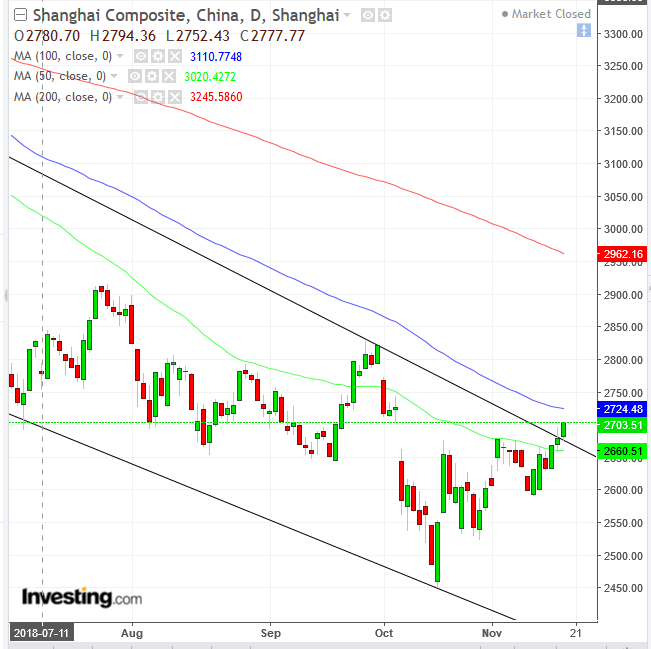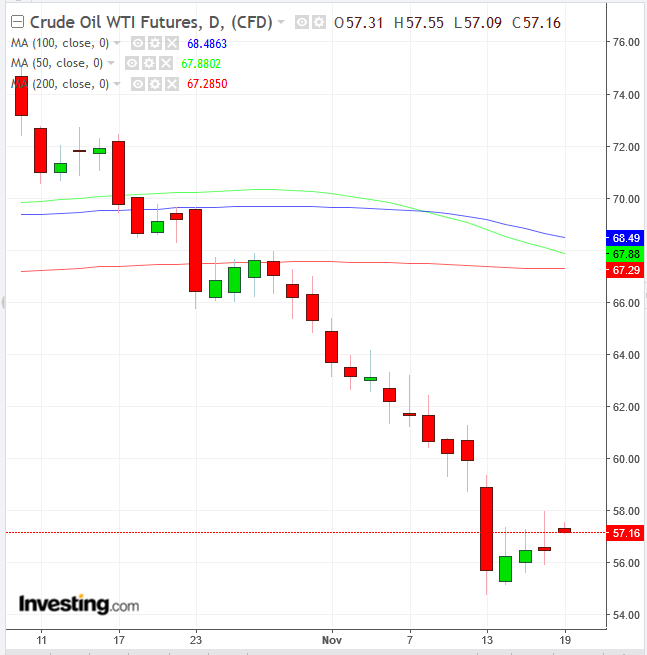- Futures waver as European shares hold onto positive territory amid heightened trade tensions
- APEC summit ends without joint statement for the first time ever after US attack on China over trade
- Oil edges higher for a fourth day
- The Reserve Bank of India discusses government requests to give up some surplus reserves and loosen liquidity norms for lenders on Monday.
- Bank of England Governor Mark Carney appears before the UK Parliament on Tuesday.
- US markets will see a holiday-shortened week, with Black Friday kicking off the holiday shopping season after Thanksgiving break.
- STOXX Europe 600 gained 0.5 percent.
- Futures on the S&P 500 Index were unchanged at the highest level in more than a week.
- Italy’s FTSE MIB climbed 0.5 percent.
- The UK’s FTSE 100 crawled 0.4 percent higher, the biggest increase in more than a week.
- The MSCI All-Country World Index climbed 0.2 percent to the highest level in more than a week.
- The Dollar Index lost less than 0.01 percen.
- The euro slid 0.1 percent, the first retreat in a week.
- The British pound gained 0.2 percent to $1.2863.
- The Japanese yen fell less than 0.05 percent to 112.85 per dollar.
Key Events
Global stocks opened strongly this morning though futures on the S&P 500, Dow and NASDAQ 100 wavered as investors struggled to set aside ongoing trade risk, amid waning signs of a reprieve.
The STOXX Europe 600 rebounded after tumbling 2.2 percent last week on concerns over a potential no-confidence vote for UK Prime Minister Theresa May, as well as persisting Italian budget woes. Healthcare and construction companies led the gains, with Novartis (SIX:NOVN) climbing 1.9 percent at the open after being its rating was raised to 'buy' by Goldman Sachs Group, and Novo Nordisk (CO:NOVOb) surging 4.4 percent after being upgraded by JPMorgan. The FTSE 100 is gaining ground as investors remain alert for any further Brexit developments.
The pound edged higher as May prepared to appeal to business leaders to help deliver her Brexit deal as she fights almost insurmountable Parliamentary opposition.
Earlier, during the Asian session, equities posted a mixed performance after US Vice President Mike Spence said at the Asia Pacific Economic Cooperation (APEC) summit on Saturday that the US will persist with its trade policy, expecting China will back down—thereby providing little hope to investors that any resolution will be forthcoming in the foreseeable future. Still, Friday’s Wall Street gains boosted global trading, with the MSCI Asia Pacific Index eking out a 0.07 percent rise.

Despite heightened trade tensions, Chinese shares outperformed regional peers, with the Shanghai Composite gaining 0.91 percent. Property developers and financial companies propelled the index higher amid ongoing accommodative policy measures and market expectations of more to follow. Technically, the index broke above a falling channel since February, after having scaled above its 50 DMA. The next technical challenge for traders will be the 100 DMA, above today’s close.
While Pence’s attack on China fell short of pressuring Chinese stocks, it took a toll on two countries dependent on China’s economy, Australia and New Zealand, weighing on their shares and currencies. Australia’s S&P/ASX 200 dropped 0.64 percent, underperforming regional peers; the Dow Jones New Zealand slipped 0.49 percent. The AUD gave up 0.38 percent and the NZD slid 0.57 percent. Technically, the NZD met with the resistance of the 200 DMA.
Meanwhile, Japan's trade deficit widened in October, but its exports rebounded after being hit by natural disasters through September. Data from the Ministry of Finance showed exports grew 8.2 percent from the same month a year ago. In September, exports fell 1.2 percent from the previous year in the first decline for the world's third largest economy since 2016. Imports in October grew 19.9 percent year on year. The Nikkei 225 ticked 0.65 percent higher.
Global Financial Affairs
US stocks gained ground on Friday but ended lower for the week. Apple (NASDAQ:AAPL), a key component by weighting on both the NASDAQ Composite and the Dow Jones Industrial Average, suffered its worst week in seven months. The VIX inched up and the yield on 10-year Treasurys hit the lowest close since October 2.
The Dow is the second best performer among US majors year-to-date and boasts the strongest technical picture, whereas the Russell 2000, which works as a trade risk proxy, has underperformed its peers and is showing the weakest technical outlook. That suggests that the current risk-off mode is not motivated by trade risk fears.
As a matter of fact, the fundamentals support a continued bull market. According to US consultancy Gallup, this is the best economy in 19 years, with the highest consumer confidence in 14 years. Reinforcing the upbeat economic backdrop, corporates have just posted their best earnings results since the financial crisis—though it was also one of the most volatile reporting season in recent years. Trading activity in the US may be thin this week ahead of Thursday's Thanksgiving holiday.

Oil climbed above $57 a barrel in New York following its recent fall into a bear market, though investors are watching anxiously for any signal from OPEC on production cuts.
Investors are assessing equity and credit markets for fresh signs of volatility amid enduring concern over trade conflicts and world growth, challenged by rising US interest rates that drive financing costs higher—a headwind that was probably a key trigger of the recent selloffs. Tension between Xi Jinping and Pence quashed optimism that relations would improve at the G20 meetings starting next week, as the APEC group failed to agree on a joint statement for the first time in its history.
Up Ahead
Market Moves
Stocks
Currencies
Bonds
